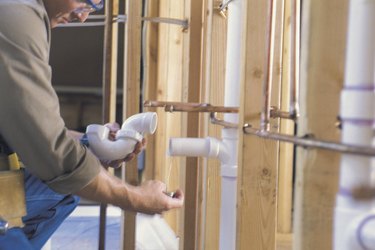Things You’ll Need
-
Reciprocating saw
-
Tape measure
-
Utility knife
-
Drill
-
2 1/2-inch hole bit
-
2-inch PVC P-trap
-
4-by-2 PVC sanitary-T reducer fitting
-
2-inch PVC pipe
-
2-inch PVC T-fitting
-
2-inch PVC connector fittings
-
PVC cleaner
-
PVC glue
 Install a P-trap between the washer and the drainpipe. Image Credit: Comstock/Comstock/Getty Images
Install a P-trap between the washer and the drainpipe. Image Credit: Comstock/Comstock/Getty Images
Water runs downward, so a home's main drain line is usually below grade. When connecting an appliance, such as a washing machine, to the drain system, follow general plumbing standards to ensure that the water drains effectively. The main drainpipe is usually found along the interior of a basement wall or crawlspace wall, but it might be in a different spot. Before connecting to the drainpipe, turn off the water supply and instruct family members not to flush a commode.
Video of the Day
Step 1
Locate the washer box. This small box, which fits between the wall studs behind the washing machine, contains the water supply valves for the washer and a short pipe that sticks out the bottom, called a stub-out.
Step 2
Figure the shortest and simplest route between the below-grade drainpipe and the stud wall nearest the washing machine. All home configurations are different, but drainpipes run horizontally between floor joists or they drop vertically between wall studs.
Step 3
Connect a 2-inch PVC P-trap to the bottom of the stub-out on the washer box. Anytime you connect any fittings, use PVC cleaner and PVC glue in accordance with each product's instructions. Use a utility knife to cut out a section of drywall, extending from the center the stud on one side of the washer box to the center of the stud on the other side. After plumbing the washer drain, replace the drywall section and tape the seams.
Step 4
Install a 2-inch PVC T-fitting on the horizontal end of the P-trap. This should be in the stud wall right behind the washing machine.There are three openings on a T-fitting. One connects to the horizontal pipe, one faces straight down, and the other faces straight up.
Step 5
Connect 2-inch PVC pipes to both the upper and the lower opening in the T-fitting. The upper pipe runs up through the stud wall, until reaches the attic, where you will connect it to the home's main vent stack. The lower opening connects to a PVC drainpipe that runs down to the drain line. When a floor or ceiling plate is in the way, use a drill, fitted with a 2 1/2-inch hole bit, to make a hole large enough to run the pipe through.
Step 6
Measure the distance from end to end of a 4-by-2 PVC sanitary reducer T-fitting. Subtract the distance of the "lips" on both sides. For example, if the sanitary T-fitting is 12 inches long from end to end, but the lips, which are the rims on each end where the pipe will fit, are each 2 inches deep, subtract 4 inches from 12 inches, leaving 8 inches. This will be the cutting measurement.
Step 7
Cut the main drainpipe with a reciprocating saw to coincide with the measurement. Most main drainpipes are 4 inches in diameter and made from PVC.
Step 8
Position the sanitary T-fitting over both ends of the cut drainpipe with the top, 2-inch connection facing upward. Use PVC cleaner and glue to attach the fitting.
Step 9
Connect the bottom of the 2-inch PVC washing machine drainpipe to the 2-inch opening of the sanitary T-fitting.
Tip
Depending upon your home's layout, you may have to add horizontal or vertical piping until the washing machine drainpipe aligns with the main drain line. Corner fittings are available for this purpose.
In the attic, use additional 2-inch PVC pipe and PVC corner fittings to connect the vent pipe to the main vent stack in the same manner you connected the drain fittings. The main stack is a 2- or 3-inch pipe that exits through the roof.
Warning
Don’t skip the addition of the P-trap, which retains a little water and prevents sewer gasses from backing up in the drain line.
If your drainpipe is made from cast iron, do not cut it. A plumber should cut a cast pipe because special tools are necessary and cast can break if not cut correctly.



























